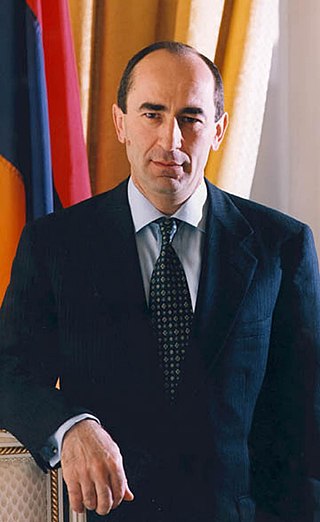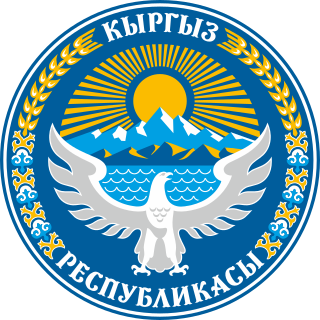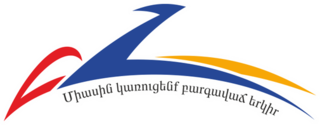
The politics of Armenia take place in the framework of the parliamentary representative democratic republic of Armenia, whereby the President of Armenia is the head of state and the Prime Minister of Armenia the head of government, and of a multi-party system. Executive power is exercised by the President and the Government. Legislative power is vested in both the Government and Parliament.

Robert Sedraki Kocharyan is an Armenian politician. He served as the President of the Nagorno-Karabakh Republic from 1994 to 1997 and Prime Minister of Nagorno-Karabakh from 1992 to 1994. He served as the second President of Armenia between 1998 and 2008 and as Prime Minister of Armenia from 1997 to 1998.

Levon Hakobi Ter-Petrosyan, also known by his initials LTP, is an Armenian politician who served as the first president of Armenia from 1991 until his resignation in 1998.

Human rights in Armenia tend to be better than those in most former Soviet republics and have drawn closer to acceptable standards, especially economically. Still, there are several considerable problems.

A new constitution of Kyrgyzstan was passed by referendum on 21 October 2007. It is based on the first post-Soviet constitution originally adopted on 5 May 1993.

Prosperous Armenia Party, is a conservative political party in Armenia. It was founded by businessman Gagik Tsarukyan on 30 April 2004, when the constituent congress of the party took place.

Parliamentary elections were held in the Nagorno-Karabakh Republic on 19 June 2005. The election saw the two pro-government parties, the Democratic Party of Artsakh and Free Motherland, win a large majority of seats. The opposition criticised the conduct of the election but international election monitors generally praised the election.

A constitutional referendum was held in Kyrgyzstan on 21 October 2007, following the constitutional crisis caused by amendments passed since the Tulip Revolution in 2005 being invalidated by the Constitutional Court of Kyrgyzstan on 14 September 2007. Voters were asked whether questions on a new constitution and electoral law. Both were approved by over 95% of voters.
Presidential elections were held in Armenia on 19 February 2008. Prime Minister Serzh Sargsyan was elected in the first round according to official results, but this was disputed by former President Levon Ter-Petrosyan, who was officially placed second.

A series of anti-government riots took place in Armenia following presidential elections held on 19 February 2008. Protests broke out in the Armenian capital Yerevan, organized by supporters of presidential candidate and former president Levon Ter-Petrosyan and other opposition leaders.

Nikol Vovayi Pashinyan is an Armenian politician serving as the prime minister of Armenia since 8 May 2018.

The 2005 Egyptian constitutional referendum took place in Egypt on 25 May 2005. The referendum was on a proposed change to the constitution of Egypt which would establish direct elections for the presidency. The opposition parties called for a boycott of the vote, which was passed by a large majority.

Presidential elections were held in Armenia on 19 February and 5 March 2003. No candidate received a majority in the first round of the election with the incumbent President Robert Kocharyan winning slightly under 50% of the vote. Therefore, a second round was held and Kocharyan defeated Stepan Demirchyan with official results showed him winning just over 67% of the vote. However, both the opposition and international observers said that the election had seen significant amounts of electoral fraud and the opposition did not recognise the results of the election.

A constitutional referendum was held in Niger on 4 August 2009. The referendum proposed the dissolution of the Fifth Republic and the creation of the Sixth Republic under a fully presidential system of government, offering a yes or no vote on the suspension of the constitution and granting President Mamadou Tandja a three-year interim government, during which the constitution of the Sixth Republic would be formulated. On 20 June, the Constitutional Court declared the plan illegal, but Tandja subsequently assumed emergency powers and dissolved the Court. The events surrounding this election led to a constitutional crisis.
The Alliance for European Integration was a centre-right anti-communist ruling coalition in Moldova from the July 2009 election until it lost to a no confidence vote in the Parliament on February 13, 2013. It was succeeded by the anti-communist Pro-European Coalition.

A constitutional referendum was held in Armenia on 6 December 2015. Its amendments to the constitution put the country on a course from having a semi-presidential system to being a parliamentary republic, with the changes beginning to take place during the 2017–18 electoral cycle. The referendum passed with 66.2% of voters supporting it. Voter turnout was 50.8%, passing the 33% threshold to validate the results.

Snap parliamentary elections were held in Armenia on 20 June 2021. The elections had initially been scheduled for 9 December 2023, but were called earlier due to a political crisis following the 2020 Nagorno-Karabakh War and an alleged attempted coup in February 2021.

A constitutional amendment took place on 22 June 2020 in Armenia. A referendum was initially scheduled for 5 April 2020, but on 16 March 2020 was indefinitely postponed as a result of the COVID-19 pandemic. In the absence of a referendum, the parliament instead voted for the constitutional amendment directly.

Snap parliamentary elections were held in Kyrgyzstan on 28 November 2021. They followed the annulment of the results of the October 2020 elections and the subsequent protests against the election's conduct. Seven parties passed the 5% threshold and will take up seats in the parliament. Turnout hit a record low at less than 35%.
A referendum was held in Kyrgyzstan on 10 January 2021 alongside presidential elections. The referendum asked voters if Kyrgyzstan should adopt a presidential system of government, a parliamentary system, or neither. 84.1% of voters chose to readopt a presidential system.












